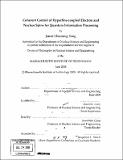Coherent control of hyperfine-coupled electron and nuclear spins for quantum information processing
Author(s)
Yang, Jamie Chiaming
DownloadFull printable version (14.85Mb)
Other Contributors
Massachusetts Institute of Technology. Dept. of Nuclear Science and Engineering.
Advisor
David G. Cory.
Terms of use
Metadata
Show full item recordAbstract
Coupled electron-nuclear spins are promising physical systems for quantum information processing: By combining the long coherence times of the nuclear spins with the ability to initialize, control, and measure the electron spin state, the favorable properties of each spin species are utilized. This thesis discusses a procedure to initialize these nuclear spin qubits, and presents a vision of how these systems could be used as the fundamental processing unit of a quantum computer. The focus of this thesis is on control of a system in which a single electron spin is coupled to N nuclear spins via resolvable anisotropic hyperfine (AHF) interactions. High-fidelity universal control of this le-Nn system is possible using only excitations on a single electron spin transition. This electron spin actuator control is implemented by using optimal control theory to find the modulation sequences that generate the desired unitary operations. Decoherence and the challenge of making useful qubits from these systems are also discussed. Experimental evidence of control using an electron spin actuator was acquired with a custom-built pulsed electron spin resonance spectrometer. Complex modulation sequences found by the GRadient Ascent Pulse Engineering (GRAPE) algorithm were used to perform electron spin echo envelope modulation (ESEEM) experiments and simple preparation-quantum operation-readout experiments on an ensemble of 1e-1n systems. The data provided evidence that we can generate any unitary operation on an AHF-coupled 1e-1n system while sitting on a single transmitter frequency. The data also guided design of the next iteration of these experiments, which will include an improved spectrometer, bandwidth-constrained GRAPE, and samples with larger Hilbert spaces.
Description
Thesis (Ph. D.)--Massachusetts Institute of Technology, Dept. of Nuclear Science and Engineering, 2008. Includes bibliographical references (p. 81-87).
Date issued
2008Department
Massachusetts Institute of Technology. Department of Nuclear Science and EngineeringPublisher
Massachusetts Institute of Technology
Keywords
Nuclear Science and Engineering.